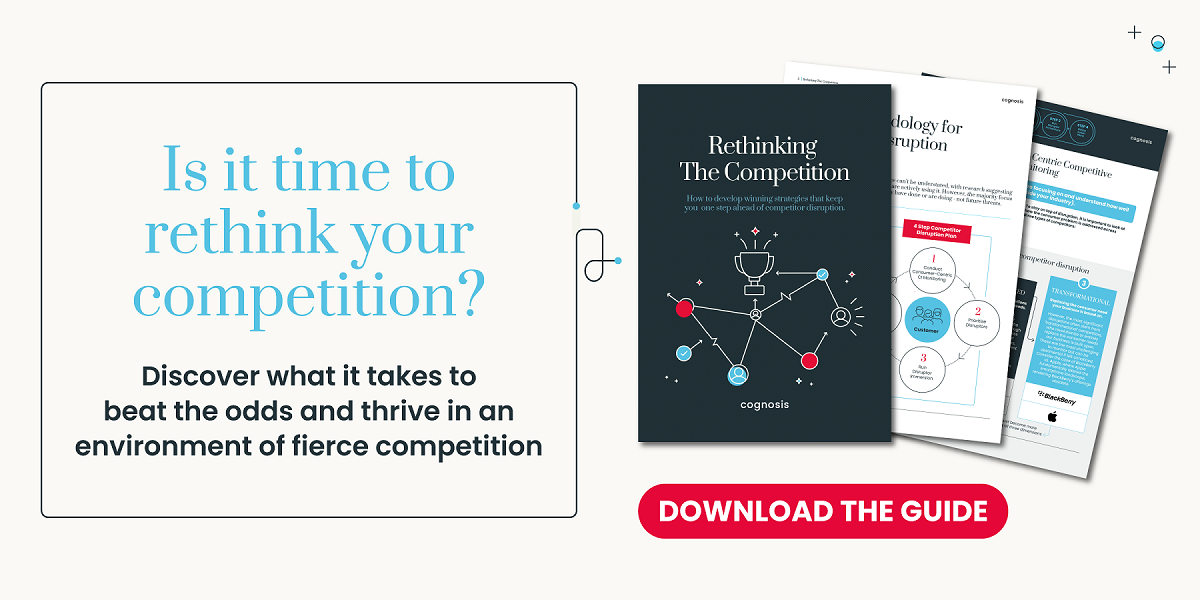Competitor analysis tools for Strategy Development
Unlocking the power of competitor analysis is crucial in crafting a strong business strategy. Yet, its effectiveness is frequently confined to ad-hoc projects, detached from the broader strategy development process. In an ever-changing landscape that demands adaptability for survival amid market disruptions, it's vital to seamlessly integrate competitor intelligence into actionable strategies in order to stay ahead of the competition.

Competitor analysis is a critical driver of any business strategy. It provides valuable insights into competitor performance, relevant opportunities and threats, and informs strategic decisions for securing competitive advantage.
However, many fail to use it effectively. Competitor analysis is commonly run as an ad-hoc project that is not integrated into the strategy development process, making it difficult to link the insight to real action. Our Cognosis approach leverages a suite of strategic tools and processes that go above and beyond data platforms to generate actionable insight that are integrated into your strategy development cycle.
> RELATED ARTICLE: Strategy development vs Strategy implementation: 3 Differences
Let's take a closer look at these four competitor analysis tools:
TOOL #1 Competitor Benchmarking
What is it? The process of looking at your own performance relative to your competition, looking into aspects that influence performance such as financials, quality of proposition, capabilities, pricing strategies and customer satisfaction, to name a few.
While it may be common practice to benchmark your largest competitors, it is important to also conduct benchmarking against new disruptors, who often fly under the radar, operate across multiple industries and have a very distinct set of capabilities. This will help you identify new technological advances that may be unrecognised in your own ‘traditional’ industry and ensure you have the right set of capabilities to compete effectively against disruptors.
Competitor benchmarking will help you identify your competitors’ strengths, weaknesses, key threats and opportunities and track your strategic performance on an ongoing basis. It is important that you tailor your benchmarking to your long-term goals and use specific and appropriate indicators to track your progress.
TOOL #2 Value Proposition evaluation
A unique value proposition analysis is another important tool that should be conducted in every strategy cycle to sense check the strength of your point of difference. To stress test your value proposition, you must understand what your brand does well and what unique features define your business. You must also be clear on what you do better than your competitors and how you can satisfy your customers needs. Your unique value proposition should sit at the heart of your strategy and all marketing communications.
Our research shows that businesses that achieve sustainable growth are those that reach beyond the current business model and respond to a changing environment with more speed and precision than the competition. They’re not just responsive to customer needs, but proactively anticipating and setting out to satisfy future needs.
TOOL #3 Business wargaming and Competitor Simulations
What is it? Business wargaming is a strategic tool used by organisations to simulate competitive scenarios, test strategies, and analyse potential outcomes in a controlled and risk-free environment. The term draws its inspiration from military war games, where military commanders simulate various battle scenarios to develop and test their strategies. In the business context, wargaming involves creating a simulated environment that mirrors the competitive landscape in which a company operates.
Business wargaming should be a non-negotiable exercise in any strategy development process. There are two types of games that can be played, the first are games for formulating a new strategy (landscape games) and the second are games for testing an existing strategy (test games). As a result, wargaming should be integrated into the overall strategy development process, both pre and post strategy formulation.
New opportunities and risks are often missed when individuals are too ingrained in their day-to-day jobs. These can be identified by stepping into the shoes of competitors and seeing the world from a different perspective. Depending on the industry it may also be useful to wargame other stakeholders such as regulators, consumers, retailers and suppliers on a regular basis.
TOOL #4 An early warning monitoring system
Keeping your benchmarks and long-term goals at the forefront of your strategy will give you ongoing confirmation that you’re focusing on the right areas or provide the insight to help you adjust quickly if you’re not. This can carried be out through an 'Early Warning System' dashboard.
The dashboard and accompanying process is designed to alert decision-makers to potential threats and opportunities in the competitive landscape, allowing businesses to proactively adjust their strategies. An Early Warning System offers a single view of critical competitor KPI’s and risk indicators in a dashboard that is updated regularly.
In the event that a key KPI does hit ‘danger levels’, leadership are alerted and able to respond with agility, putting appropriate pre-agreed course of action into motion. An Early Warning System is the essential bridge between hypothetical risk identification and management action.
Traditional strategy development often relies on historical data. An Early Warning System, however, integrates real-time intelligence into the decision-making process. This ensures that strategic goals align dynamically with the ever-evolving competitive environment, fostering adaptability and resilience.
Dealing with market disruption
A strategic plan needs to be adaptive to survive against market disruption. A word of caution - while there are many good off-the-shelf competitor analysis tool that provide you with some interesting raw data, they are not adaptive and won't deliver personalised insight directly linked to your strategic decision making process. With the competitor landscape continuing to evolve and the pace of disruption accelerating, often the greatest competitor threats come from companies outside your industry.
To avoid nasty surprises it’s important to integrate these four competitor analysis tools into the strategy development process to identify, track and signal new threats and opportunities and stay ahead of the pack.
> RELATED ARTICLE: Using business wargaming to achieve competitive advantage


